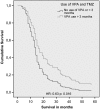Effect of valproic acid on seizure control and on survival in patients with glioblastoma multiforme
- PMID: 23680820
- PMCID: PMC3688020
- DOI: 10.1093/neuonc/not057
Effect of valproic acid on seizure control and on survival in patients with glioblastoma multiforme
Abstract
Background: To examine the efficacy of valproic acid (VPA) given either with or without levetiracetam (LEV) on seizure control and on survival in patients with glioblastoma multiforme (GBM) treated with chemoradiation.
Methods: A retrospective analysis was performed on 291 patients with GBM. The efficacies of VPA and LEV alone and as polytherapy were analyzed in 181 (62%) patients with seizures with a minimum follow-up of 6 months. Cox-regression survival analysis was performed on 165 patients receiving chemoradiation with temozolomide of whom 108 receiving this in combination with VPA for at least 3 months.
Results: Monotherapy with either VPA or LEV was instituted in 137/143 (95.8%) and in 59/86 (68.6%) on VPA/LEV polytherapy as the next regimen. Initial freedom from seizure was achieved in 41/100 (41%) on VPA, in 16/37 (43.3%) on LEV, and in 89/116 (76.7%) on subsequent VPA/LEV polytherapy. At the end of follow-up, seizure freedom was achieved in 77.8% (28/36) on VPA alone, in 25/36 (69.5%) on LEV alone, and in 38/63 (60.3%) on VPA/LEV polytherapy with ongoing seizures on monotherapy. Patients using VPA in combination with temozolomide showed a longer median survival of 69 weeks (95% confidence interval [CI]: 61.7-67.3) compared with 61 weeks (95% CI: 52.5-69.5) in the group without VPA (hazard ratio, 0.63; 95% CI: 0.43-0.92; P = .016), adjusting for age, extent of resection, and O(6)-DNA methylguanine-methyltransferase promoter methylation status.
Conclusions: Polytherapy with VPA and LEV more strongly contributes to seizure control than does either as monotherapy. Use of VPA together with chemoradiation with temozolomide results in a 2-months' longer survival of patients with GBM.
Keywords: epilepsy; glioblastoma multiforme; levetiracetam; survival; valproic acid.
Figures
Comment in
-
Are we ready for a randomized trial of valproic acid in newly diagnosed glioblastoma?Neuro Oncol. 2013 Jul;15(7):809-10. doi: 10.1093/neuonc/not095. Neuro Oncol. 2013. PMID: 23788268 Free PMC article. No abstract available.
References
-
- Stupp R, Mason WP, van den Bent MJ, et al. Radiotherapy plus concomitant and adjuvant temozolomide for glioblastoma. N Engl J Med. 2005;352:987–996. - PubMed
-
- Stupp R, Hegi ME, Mason WP, et al. Effects of radiotherapy with concomitant and adjuvant temozolomide versus radiotherapy alone on survival in glioblastoma in a randomised phase III study: 5-year analysis of the EORTC-NCIC trial. Lancet Oncol. 2009;10:459–466. - PubMed
-
- van Breemen MS, Rijsman RM, Taphoorn MJ, Walchenbach R, Zwinkels H, Vecht CJ. Efficacy of anti-epileptic drugs in patients with gliomas and seizures. J Neurol. 2009;256:1519–1526. - PubMed
-
- Wick W, Menn O, Meisner C, et al. Pharmacotherapy of epileptic seizures in glioma patients: who, when, why and how long? Onkologie. 2005;28:391–396. - PubMed
-
- Glantz MJ, Cole BF, Forsyth PA, et al. Practice parameter: anticonvulsant prophylaxis in patients with newly diagnosed brain tumors. Report of the Quality Standards Subcommittee of the American Academy of Neurology. Neurology. 2000;54:1886–1893. - PubMed
MeSH terms
Substances
LinkOut - more resources
Full Text Sources
Other Literature Sources
Medical




